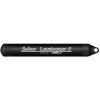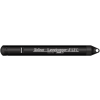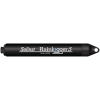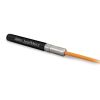Solinst Barologger 5 Barometric Pressure Logger
The Solinst Barologger 5 uses pressure algorithms based on air rather than water pressure to provide accuracy for barometric pressure compensation of Levelogger data.
Features
- Single-eye optical interface for easy cleaning and scratch-resistance
- Increased memory: 150,000 sets of data
- Data Compensation Wizard in the Levelogger Software simplifies barometric compensation
- Free ground shipping
- Expedited repair and warranty service
- Lifetime technical support
- More
Overview
The Solinst Barologger 5 is used to measure absolute pressure (water pressure + atmospheric pressure) expressed in feet, meters, centimeters, psi, kPa, or bar. The most accurate method of obtaining changes in water level is to compensate for atmospheric pressure fluctuations using a Barologger 5, avoiding time lag in the compensation.
Superior Accuracy
The Barologger 5 is set above high water level in one location on site. One Barologger can be used to compensate all Leveloggers in a 30 km (20 mile) radius and/or with every 300 m (1000 ft.) change in elevation. The Levelogger Software Data Compensation Wizard automatically produces compensated data files using the synchronized data files from the Barologger and Leveloggers on site. The Barologger 5 uses pressure algorithms based on air rather than water pressure, giving superior accuracy. The recorded barometric information can also be very useful to help determine barometric lag and/or barometric efficiency of the monitored aquifer.
Automatically Adjusts Measurements
The Barologger 5 records atmospheric pressure in psi, kPa, or mbar. When compensating submerged Levelogger 5, Edge, Gold or Junior data, Levelogger Software can recognize the type of Levelogger and compensate using the same units found in the submerged data file (e.g. feet or meters), making the Barologger 5 backward-compatible.
In The News
Three Decades of Research at Acton Lake
A multi-disciplinary team at Miami University, Ohio, has been studying the environmental change at Acton Lake for over three decades. Using three different NexSens buoys over this time, the team has an incredible archive of data that is helping build a picture of Acton’s past, present, and future. Until recently, a NexSens CB-50 buoy was used alongside other environmental monitoring at Acton Lake. In May 2025, the Miami team deployed a new XB-200 buoy , future-proofing their ongoing monitoring using real-time buoy systems. Acton Lake, a small hypereutrophic reservoir in southwest Ohio, covers 2.4km² and has a maximum depth of about 8m. The dam was built in 1956, and the lake has a large agricultural watershed.
Read MoreSource Water Monitoring in Albany, New York: Tracing Water Quality throughout Tributaries
Thousands of US cities pull their drinking water from natural source waters like reservoirs, rivers, and streams, making overall watershed health a key consideration for water providers. In Albany, New York, the Albany Department of Water and Water Supply delivers drinking water to over 100,000 residents as well as monitors and manages the larger drinking water supply watershed. Hannah Doherty, Environmental Specialist at the Albany Department of Water and Water Supply , spends her days working with a small team to monitor the drinking supply and the connected water bodies. Doherty explains, “We’re the first to encounter the water that ends up being the drinking water.
Read MoreWildfire Prevention in the Sierra Nevada Region with the Yuba Watershed Institute
Though recent wildfires have sparked new conversations about wildfire management and response, groups like the Yuba Watershed Institute have been monitoring the forests and water resources of the Sierra Nevada region for decades, managing approximately 5,000 acres of land with the Bureau of Land Management (BLM) and about 7,000 acres in private land partnerships. The goal of the Institute is to work with local communities and land agencies to improve watershed and forestry management through informed practices and public outreach. The goals of the Yuba Watershed Institute are three-fold: Improve the ability of fire suppression agencies like the California Department of Forestry and Fire Protection ( CAL FIRE ) and the US Forest Service.
Read More


















































